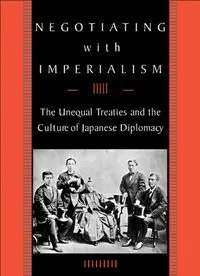
Negotiating with Imperialism The Unequal Treaties and the Culture of Japanese Diplomacy - Michael R Auslin PDF
Preview Negotiating with Imperialism The Unequal Treaties and the Culture of Japanese Diplomacy - Michael R Auslin
Negotiating with Imperialism Co17 R39 L 40 Negotiating with Imperialism L 40 � M I C H A E L R . A U S L I N HARVARD UNIVERSITY PRESS Cambridge, Massachusetts, and London, England 2004 T H E U N E Q U A L T R E AT I E S A N D T H E C U LT U R E O F J A PA N E S E D I P L O M A C Y Copyright © 2004 by the President and Fellows of Harvard College All rights reserved Printed in the United States of America Library of Congress Cataloging-in-Publication Data Auslin, Michael R., 1967– Negotiating with imperialism : the unequal treaties and the culture of Japanese diplomacy / Michael R. Auslin. p. cm. Includes bibliographical references and index. 1. Japan—Foreign relations—19th century—Treaties. United States—Treaties. 3. United States—Foreign relations—Japan—Treaties. I. Title. DS881.45.A97 2004 327.52073'09'034—dc22 2004054126 First Harvard University Press paperback edition, 2006 ISBN13 978-0-674-01521-0 (cloth) ISBN10 0-674-01521-5 (cloth) ISBN13 978-0-674-02227-0 (pbk.) ISBN10 0-674-02227-0 (pbk.) 2. Japan—Foreign relations— For Ginko and Benjamin L 40 Contents Co17 R39 L 40 Author’s Note ix Introduction 1 1 The Style and Substance of Treaty-Making 11 2 Negotiating Space: The Meaning of Yokohama 34 3 Negotiating Time: The Postponement Strategy 61 4 The Limits of Negotiation: Expulsion and Gunboats 89 5 New Horizons: Tariffs and Translations 118 6 Rethinking Negotiation: Moving toward Revision 146 7 Negotiating the Future: The Iwakura Mission in America and Britain 176 Conclusion 201 Appendix 1: Treaties of Friendship and Commerce Signed by the Tokugawa Bakufu and the Meiji Government 211 Appendix 2: Key Japanese and Western Diplomats 212 Appendix 3: Treaty of Amity and Commerce between the United States and Japan, July 29, 1858 214 Abbreviations 222 Notes 223 Acknowledgments 249 Index 253 viii • Contents Author’s Note Co17 R39 L 40 Japanese names are given in traditional order: surname first, given name second. Following Japanese convention, however, certain indi- viduals are referred to in the text by their given name; in particular, Hitotsubashi Keiki as Keiki (similarly after his shogunal name change to Tokugawa Yoshinobu as Yoshinobu), his father Tokugawa Nariaki as Nariaki, the lords of Satsuma Shimazu Nariakira and Shimazu Hisamitsu as Nariakira and Hisamitsu, Matsudaira Katamori as Katamori, Matsudaira Keiei as Keiei, and the artist Hashimoto Sadahide as Sadahide. For convenience’s sake, all dates have been changed to the Western calendar.
